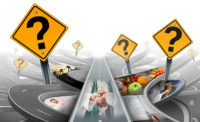Complacency depends on what you’re doing

Maryland’s Eastern Shore is gorgeous, green waterfront land, with creeks and rivers leading into the Chesapeake Bay. I took a swim across one of those rivers, the Sassafras River, a few weeks ago. Wasn’t a hard swim; maybe a quarter mile to small island. I hadn’t swam since the pandemic lockdown in March, and was eager to dive in. I arrived at a friend’s house for the weekend and decided on the swim while he was out.
I reached a beach on the island and turned around to look for my friend’s dock. Couldn’t pick it out from more than dozen docks dotting the waterfront. No problem. If I just swim in a straight line back the way I came I’ll come up around his dock.
Easier said than done. Swimming in a river, even without any kind of strong churn, can be disorienting. It’s difficult to see above the water line. You don’t have the visibility that you would in a motorboat. And the current, subtle as it might be, can push you off course.
I went off course. Swimming in what I thought was the direction to my friend’s dock, I came up on a dock that was definitely not his. Thinking his dock was nearby, I could swim over to it. But thunder was in the air and I climbed out of the water. The owner of the dock I found came out of his house and asked if I needed a ride back to my friend’s place. “No, thanks, it’s not far. I can walk.” “Do you want flip-flops for the walk?” he asked. “No, it’s not far. Thanks.”
It wasn’t far as the crow flies. But creeks, large McMansion properties with cameras and “No Trespassing” warnings, and twisting, turning roads make it impossible to simply cut across the waterfront. Out on the roads I got totally lost. Locals must have thought I was homeless or on drugs. I had no cell phone. Nothing but my swim trunks and goggles. I walked around, sometimes in circles, for almost two hours. My feet were blistering. An off-duty policeman saw me walking, then saw me walking 20 minutes later. He stopped his car, took mercy on me, told me to hop in, and drove me back to my friend’s place.
“Where the hell have you been?” my buddy asked me. “I got complacent.” Thought it would be an easy swim across the river and back. Never mind I had never visited his place before. Didn’t know the lay of the land. Complacency got me good.
Different situation, different attitude
In Philadelphia, where I live, I ride my bike a lot. Especially since the lockdown. Be careful, it’s dangerous riding in the city, neighbors told me when I first got the bike. They were so right. On narrow streets you brush by cars, inches apart. You swerve around double-parked trucks. Watch out for potholes. You dodge around strollers, runners, slower bikers on trails, and look over your shoulder for faster bikes overtaking you. Your head is on a swivel. I don’t plug in wireless earbuds and listen to tunes; don’t talk to anyone on my iPhone. I need situational awareness. There’s little margin for error and no room for complacency.
Complacency is a feeling of smugness. Of quiet pleasure while you’re unaware of lurking dangers. You accept things around you as non-changing. I believe complacency is situational. Do a task a thousand times and you can run on auto-pilot. But if you know risks abound, know you can get hurt if you don’t pay attention, complacency goes out the window.
As well it should, no matter the situation. I erred being over-confident on that swim. I don’t make that mistake when I’m bike riding in the city. Complacency is a challenge to overcome. It’s part of human nature. But it’s definitely the enemy of safety.
Looking for a reprint of this article?
From high-res PDFs to custom plaques, order your copy today!






